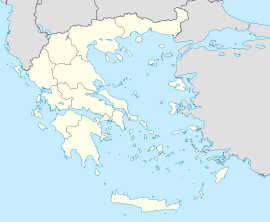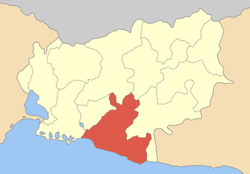- Maroneia
-
Maroneia
Μαρώνεια
Location Coordinates 40°54′N 25°31′E / 40.9°N 25.517°ECoordinates: 40°54′N 25°31′E / 40.9°N 25.517°E Government Country: Greece Region: East Macedonia and Thrace Regional unit: Rhodope Municipality: Maroneia-Sapes Population statistics (as of 2001) Municipal unit - Population: 7,644 Other Time zone: EET/EEST (UTC+2/3) Auto: ΚΟ Maroneia (Greek: Μαρώνεια) is a village and a former municipality in the Rhodope peripheral unit, East Macedonia and Thrace, Greece. Since the 2011 local government reform it is part of the municipality Maroneia-Sapes, of which it is a municipal unit.[1] Population 7,644 (2001). The seat of the municipality was in Xylagani.
In legend, it was said to have been founded by Maron, a son of Dionysus,[2] or even a companion of Osiris.[3] According to Pseudo-Scymnus it was founded by Chios in the first half of the 6th century BC.[4] According to Pliny, its ancient name was Ortagures.[5] It was located on the hill of Aghios Gheorgis, and archaeological findings date it as a much older and as a pure Thracian city.
Maroneia was close to the Ismaros mentioned by Homer in the Odyssey.[6] Some scholars identify Maroneia with his Ismaros.[7] Homer has Odysseus plundering the city but sparing Maron, whom he identifies as a priest of Apollo. Maron presents Odysseus with a gift of wine, as well as with gold and silver.
In the era of Ancient Greece and Rome, Maroneia was famous for its wine production. The wine was esteemed everywhere; it was said to possess the odor of nectar,[8] and to be capable of mixture with twenty or more times its quantity with water.[9] That the people of Maroneia venerated Dionysus, we learn not just from its famous Dionysian Sanctuary, the foundations of which can still be seen today, but also from the city's coins.
In 200 BC it was taken by Philip V of Macedon, who vented his rage by slaughtering a great number of the city's inhabitants.[10] The Roman Republic subsequently granted Maroneia to Attalus, King of Pergamon, but almost immediately revoked their gift and declared it a free city.[11]
In December 1877 Captain Petko Voyvoda liberated the town from the Ottomans, and establish the Bulgarian administration here.
Notable people
- Metrocles (4th century BC), Cynic philosopher
- Hipparchia, Cynic philosopher and sister of Metrocles
- Sotades (3rd century BC), poet
- Petko Kiryakov (Captain Petko Voyvoda) (1844–1900), leader of the Bulgarian national revolution in Aegean Thrace and Rhodopes 1861-1878, friend of Giuseppe Garibaldi, organiser and commander of the iatalo-bulgarian Battalion in Greece Cretan Revolt (1866–1869), Bulgarian politician
Notes
- ^ Kallikratis law Greece Ministry of Interior (Greek)
- ^ Euripides, Cyclops, v. 100, 141
- ^ Diodorus Siculus, i. 20
- ^ Pseudo-Scymnus, 676 ff
- ^ Pliny, iv. 11. s. 18
- ^ Homer, Odyssey, ix. 196-211
- ^ Isaac, B., (1986), The Greek Settlements in Thrace Until the Macedonian Conquest, page 113. BRILL.
- ^ Nonnus, i. 12, xvii. 6, xix. 11
- ^ Homer, Odyssey, ix. 209; Pliny, xiv. 4. s. 6
- ^ Livy, xxxi. 16; xxxix. 24; Polybius, xxii. 6, 13, xxiii. 11, 13
- ^ Polybius, xxx. 3
Sources
- Durando, Furio, Greece, a guide to the archaeological sites, 2004.
 "Maronia". Catholic Encyclopedia. New York: Robert Appleton Company. 1913.
"Maronia". Catholic Encyclopedia. New York: Robert Appleton Company. 1913.- Smith, William, (1857), Dictionary of Greek and Roman Geography.
- Psoma, Selene, Chryssa Karadima and Domna Terzopoulou, The Coins from Maroneia and the Classical City at Molyvoti: a contribution to the history of Aegean Thrace (Athens: Diffusion de Boccard, 2008) (Meletemata, 62).
Categories:- Populated places in Rhodope (peripheral unit)
- Ionian colonies in Thrace
- East Macedonia and Thrace geography stubs
Wikimedia Foundation. 2010.




